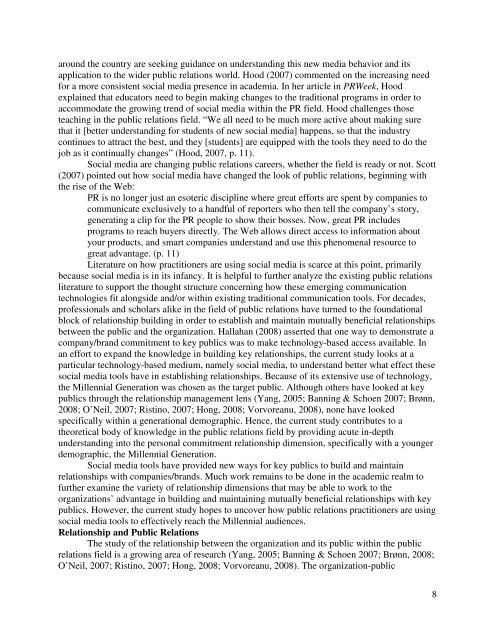2010 - Public Relations Society of America
2010 - Public Relations Society of America
2010 - Public Relations Society of America
Create successful ePaper yourself
Turn your PDF publications into a flip-book with our unique Google optimized e-Paper software.
around the country are seeking guidance on understanding this new media behavior and its<br />
application to the wider public relations world. Hood (2007) commented on the increasing need<br />
for a more consistent social media presence in academia. In her article in PRWeek, Hood<br />
explained that educators need to begin making changes to the traditional programs in order to<br />
accommodate the growing trend <strong>of</strong> social media within the PR field. Hood challenges those<br />
teaching in the public relations field. “We all need to be much more active about making sure<br />
that it [better understanding for students <strong>of</strong> new social media] happens, so that the industry<br />
continues to attract the best, and they [students] are equipped with the tools they need to do the<br />
job as it continually changes” (Hood, 2007, p. 11).<br />
Social media are changing public relations careers, whether the field is ready or not. Scott<br />
(2007) pointed out how social media have changed the look <strong>of</strong> public relations, beginning with<br />
the rise <strong>of</strong> the Web:<br />
PR is no longer just an esoteric discipline where great efforts are spent by companies to<br />
communicate exclusively to a handful <strong>of</strong> reporters who then tell the company’s story,<br />
generating a clip for the PR people to show their bosses. Now, great PR includes<br />
programs to reach buyers directly. The Web allows direct access to information about<br />
your products, and smart companies understand and use this phenomenal resource to<br />
great advantage. (p. 11)<br />
Literature on how practitioners are using social media is scarce at this point, primarily<br />
because social media is in its infancy. It is helpful to further analyze the existing public relations<br />
literature to support the thought structure concerning how these emerging communication<br />
technologies fit alongside and/or within existing traditional communication tools. For decades,<br />
pr<strong>of</strong>essionals and scholars alike in the field <strong>of</strong> public relations have turned to the foundational<br />
block <strong>of</strong> relationship building in order to establish and maintain mutually beneficial relationships<br />
between the public and the organization. Hallahan (2008) asserted that one way to demonstrate a<br />
company/brand commitment to key publics was to make technology-based access available. In<br />
an effort to expand the knowledge in building key relationships, the current study looks at a<br />
particular technology-based medium, namely social media, to understand better what effect these<br />
social media tools have in establishing relationships. Because <strong>of</strong> its extensive use <strong>of</strong> technology,<br />
the Millennial Generation was chosen as the target public. Although others have looked at key<br />
publics through the relationship management lens (Yang, 2005; Banning & Schoen 2007; Brønn,<br />
2008; O’Neil, 2007; Ristino, 2007; Hong, 2008; Vorvoreanu, 2008), none have looked<br />
specifically within a generational demographic. Hence, the current study contributes to a<br />
theoretical body <strong>of</strong> knowledge in the public relations field by providing acute in-depth<br />
understanding into the personal commitment relationship dimension, specifically with a younger<br />
demographic, the Millennial Generation.<br />
Social media tools have provided new ways for key publics to build and maintain<br />
relationships with companies/brands. Much work remains to be done in the academic realm to<br />
further examine the variety <strong>of</strong> relationship dimensions that may be able to work to the<br />
organizations’ advantage in building and maintaining mutually beneficial relationships with key<br />
publics. However, the current study hopes to uncover how public relations practitioners are using<br />
social media tools to effectively reach the Millennial audiences.<br />
<strong>Relations</strong>hip and <strong>Public</strong> <strong>Relations</strong><br />
The study <strong>of</strong> the relationship between the organization and its public within the public<br />
relations field is a growing area <strong>of</strong> research (Yang, 2005; Banning & Schoen 2007; Brønn, 2008;<br />
O’Neil, 2007; Ristino, 2007; Hong, 2008; Vorvoreanu, 2008). The organization-public<br />
8
















